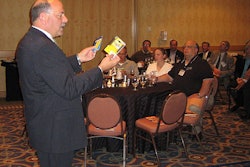This spring, ODIN technologies and Unisys Corp. released the results of the study, Pharmaceutical Item Level RFID: Battle of the Frequencies. It is claimed as the first scientific high frequency (HF) vs. ultra-high frequency (UHF) RFID evaluation geared specifically toward the pharmaceutical industry's stringent requirements for serialized item-level product tracking. We reveal some exclusive, key findings from the study.
Background: The pharmaceutical industry is being driven by regulators at the state and federal level to take additional steps to ensure the safety and authenticity of medicines. In the February 2004 report, Combating Counterfeit Drugs, the FDA concluded that, "Radio-frequency identification (RFID) tagging of products by manufacturers, wholesalers, and retailers appears to be the most promising approach to reliable product tracking and tracing. Most importantly, reliable RFID technology will make the copying of medications either extremely difficult or unprofitable."
"RFID is clearly important to improving consumer drug safety," says Patrick Sweeney II, ODIN technologies' president and CEO. "Much of the recent debate about the merits of high frequency or ultra-high frequency RFID at the item level has been founded on anecdotes and narrow business interests. The debate amongst regulators, end-users, and supply chain participants is which RFID frequency will work best at the item level? In this report, our scientific analysis of pharmaceutical item-level tracking sets the record straight. The research presents solid, physics-based answers to help guide regulators and drug manufacturers in making successful decisions to improve drug safety."
All tests were conducted with hardware and tags that are available in production quantities to end-users today. No prototype or hand-built artifacts were allowed in the research as they are untested in production environments and prototype demonstrations are often misleading.
Exclusive findings revealed
ODIN technologies shared with Packaging Insights exclusive findings from the portion of the study that concentrated on how successful each frequency is for reading multiple closely packed items at a short distance:
1) UHF performance is dependent on material type. Even more vivid than read verification, it is clear that UHF performance is degraded significantly when applied to fluids, particularly on the bottom layer of a double layered carton. UHF power is able to reach a top layer of containers more effectively than a bottom layer.
2) HF performance is NOT dependent on material type. HF tags for all practical purposes perform identically when applied to both empty and fluid-filled containers.
3) HF performance is speed dependent. Although perfect capture rates can be achieved at 15 fpm, HF misses tags at higher speeds. This is indicative of its lower data transfer rate.
4) UHF performance is NOT speed dependent. UHF performance is constant across all three speeds tested; either consistently strong on empty containers, or consistently weak on fluid-filled containers. The results confirm that either technology works effectively on empty containers, but only HF works on fluids. This finding comes with an important caveat: HF tags do not perform as well at high speed.
Unit-level reads of cased items must account for the time required to capture large volumes of tags. Also, the system must be designed with this in mind.
The study also made a bold conclusion: With UHF not performing well on liquids, the win must go to HF. HF RFID will allow authentication to occur without unpacking and manually handling items individually.
Test parameters
Key metrics that were tested included:
• Read Distance - how far away item level tags can be read by RFID readers
• Orientation Sensitivity - how well can tags be read when they are oriented away from a reader antenna; this is particularly important for uses in totes and for authentication reads performed by drug distributors
• Material Dependence - how well can tags be read when on liquid bottles or blister packs as opposed to powder or pill filled bottles
• Maximum Encode Speed - how fast can RFID tags be encoded
• Tag Quality - how consistent is tag quality for each frequency
After completing scientific tag testing, ODIN technologies and Unisys extended this study to include RFID applications typical in the pharmaceutical supply chain. The team used standard pill bottles, liquid filled bottles, and blister packs for the testing. The key tests included: In-motion item-level verification, a test that simulates an RFID read on a pharmaceutical packaging line; item-to-case aggregation, a test that evaluates how successful each frequency is for reading multiple closely packed items at a short distance; and item level reads for pallet stacked cases, a test that evaluates how successful each frequency is at reading items when packed in cases on pallets at distances common for supply chain applications.
These examples uncovered the core requirements of RFID as an e-Pedigree and product authentication tool in the pharmaceutical supply chain.
The study is available for $395 at www.odintechnologies.com.

























